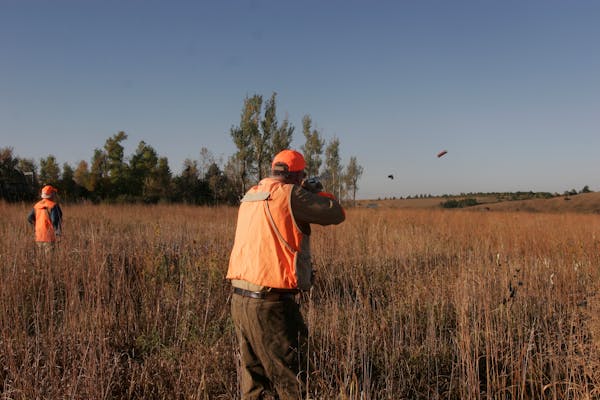LAC QUI PARLE COUNTY – 7:20 a.m. Arriving at Salt Lake Wildlife Management Area (WMA) more than an hour and a half before shooting time, Denny Lien of Lake Elmo, Will Smith of Willmar and I saw two other pickups on site.
This management area is large, and can handle more than a few parties of ringneck hunters. But safety is a concern, as is the frustration that can attend being cut off by inconsiderate hunters racing to the "best" cover. Communication is important in these instances, and after a brief conversation with the hunters who arrived ahead of us, we parked a good distance away, planning at the 9 a.m. opening bell to head west, while they tromped east.
We had stayed in Granite Falls on Friday night, and brought our breakfast with us in a cooler. Over more than four decades of starting the pheasant season on public land, we've attempted when possible to eat breakfast in small-town cafes before heading out. But this year we worried that such a dalliance might delay our arrival at Salt Lake, so we brought cereal, milk, orange juice, grapes, bananas and coffee with us, and as the sun gathered along the eastern horizon, we dined in my truck, thinking pheasants.
• • •
9 a.m. Two of my two Labs, Allie and Griz, were hunting with us, as was Willy's golden retriever, Rufus. Casting this trio ahead, we stepped into good-looking cover; thick enough to hide birds, yet not impenetrable, either to us or the dogs.
Ever hopeful, we assumed birds would arise before us. The morning was peerless, with a cloudless sky and only a slight southerly breeze. We were fully aware that June rains dumped on this part of Minnesota (as they did elsewhere), and that many pheasant nests were wiped out. Neither did it escape us that, while many farmers have harvested their beans in recent days, most of the state's corn is still in the fields. None of this worked in our favor. Still, the three of us have killed a lot of birds on opening days on public land, and we figured we would again.
• • •
10:45 a.m. We put no birds to wing on our first walk, and drove to another wildlife management area about 5 miles away. This was an out-of-the-way WMA we thought might have been overlooked by other hunters.
Not so. As we drove in, Mark LaVigne of Minneapolis, hunting by himself, drove out.
"Nothing," he said when I asked what he had seen. A pheasant hunter with 35 seasons to his credit, LaVigne had his Boykin spaniel, Belle, along. "This is the quietest opener I've ever seen," he said. "But I won't quit."
Not far away, just beginning their walks on the same management area, Ralph Feld of Cold Spring and Ken Fruth of Avon were hunting with Feld's stepsons, Andrew Laudenbach, 25, and Nick Laudenbach, 23, both of St. Joseph. The young men's cousin, Ryan Canfield, 24, was also along.
"Andrew got a rooster on our first walk, '' said Feld, who along with Fruth is active in the Stearns County Pheasants Forever chapter.
"But that's it for us so far."
• • •
Noon. The plan was to hunt our way toward the Dave Vesall Wildlife Management Area about a mile east of Marietta. Dave's been passed on some years now. But he was a good friend of mine, as was his wife, Betty, though I didn't meet them until after Dave had retired as a fish and game chief with the Department of Natural Resources.
Some history here:
Dave was among a handful of DNR wildlife managers who in the 1950s were charged with establishing a "Save the Wetlands" program in Minnesota. Dave was a hunter, and he loved fooling spring bluegills with his fly rod. But first and foremost he was a conservationist, and though he realized the "Save the Wetlands" program would never counter the full magnitude of resources that had been lost in Minnesota, he knew something had to be done. So on behalf of the DNR, he and others started buying and protecting wetlands across the state's southern and western farmlands, hoping to conserve prairie wildlife in the state forever.
Years ago, not long after Dave died, a bunch of us gathered on a hill in what is now the Dave Vesall WMA and listened as the late Roger Holmes, himself a legendary DNR fish and wildlife chief, spoke about Dave and the resources he protected.
Somehow I thought Dave was watching over Denny, Willy and me in early afternoon Saturday when we pulled into a parking lot at his namesake WMA.
Minnesota has never known anyone who believed more fervently than Dave did in the importance of public lands, and here we were, benefiting from his hard work.
Inscribed in granite at Dave's WMA are these words:
"His foresight, compassion and dedication to the resources of Minnesota laid the framework for the wildlife management system we know today."
Or, as Dave would put it, "If there's no public land, the average guy has no place to go."
We had a place to go on Saturday. And we did see three pheasants, all hens, on Dave's WMA.
Until Minnesota's corn is harvested, that will have to suffice.
Dennis Anderson • danderson@startribune.com
Anderson: Anglers protesting tough new Mille Lacs rules are wrong

Anderson: Courts, not politicians, should rule on Red Lake, White Earth lands

Anderson: Multimillion windfall gets invasive carp deterrent moving
![A young whitetail deer searches for food as another blanket of snow coats the arrowhead. ] Minnesota -State of Wonders, Arrowhead in Winter BRIAN PETE](https://arc.stimg.co/startribunemedia/WK32UWWY6FKNWJUIYCJ6ZPT4AU.jpg?h=91&w=145&fit=crop&bg=999&crop=faces)
Anderson: In NE Minnesota, DNR staff, habitat and deer all decline


